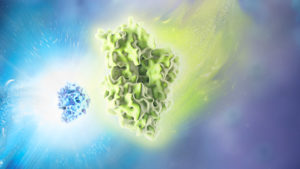
Transcriptional activation of genes within the nucleus of eukaryotic cells occurs by a variety of mechanisms. Typically, these mechanisms rely on the interaction of regulatory proteins (transcriptional activators or repressors) with specific DNA sequences that control gene expression. Upon DNA binding, regulatory proteins also interact with other proteins that are part of the RNA polymerase II transcriptional complex.
One type of transcriptional activation relies on inducing a conformational change in chromatin, the DNA-protein complex that makes up each chromosome within a cell. In a broad sense, “extended” or loosely wound chromatin is more accessible to transcription factors and can signify an actively transcribed gene. In contrast, “condensed” chromatin hinders access to transcription factors and is characteristic of a transcriptionally inactive state. Acetylation of lysine residues in histones—the primary constituents of the chromatin backbone—results in opening up the chromatin and consequent gene activation. Disruption of histone acetylation pathways is implicated in many types of cancer (1).
Bromodomain (BRD) proteins are one of several protein families that bind to acetylated lysines and affect chromatin structure (2). A subfamily of BRD proteins, known as bromodomain and extra-terminal (BET) proteins, contain several conserved domains—bromodomain 1 (BD1) and bromodomain 2 (BD2), an extraterminal (ET) domain, and the Ser/Glu/Asp (SEED)-rich domain. At present, four BET proteins are known: three of them (BRD2, BRD3 and BRD4) are expressed in most cells, while the fourth (BRDT) is testis-specific (3).
BET proteins are an attractive target for anticancer drug development, because BET inhibitors could potentially block BET interaction with acetylated histones, resulting in closed chromatin and preventing the activation of oncogenes (4). Initial results from clinical trials with BET inhibitors alone showed only modest effects in patients with advanced cancer (5). However, BET inhibitors showed promise in treating inflammatory and cardiac diseases, as well as in antiviral and antifungal therapy (6).
An alternative approach to inhibiting BET proteins is to destroy them altogether using targeted protein degradation. (For an overview, see Targeted Protein Degradation: A Bright Future for Drug Discovery.) This approach has been tested using a variety of small-molecule proteolysis-targeting chimeras (PROTACs) and has proved effective in downregulating the expression of BET-regulated genes in cancer cell lines, solid tumors, hematologic malignancies and several preclinical models (3). Significantly, much lower concentrations of BET degraders could be used in these studies, compared to BET inhibitors.
A recent study sought to overcome the therapeutic limitations of BET inhibitors by developing selective BD1 and BD2 inhibitors (7). Previous BET inhibitors targeted both the BD1 and BD2 domains common to all BET proteins; however, little is known about the functional similarities and differences between these two domains. Therefore, the researchers developed a panel of potential inhibitors, using structure-based design guided by time-resolved fluorescence resonance energy transfer (TR-FRET), to examine the individual functional characteristics of the BD1 and BD2 domains. They confirmed the selectivity of the test compounds for BD1 and BD2 in BRD4 by surface plasmon resonance (SPR). Further structural analysis (co-crystallization of test compounds and BD1/BD2 domains) revealed the molecular interactions that determined this selectivity and validated the compound design strategy.
An exhaustive array of experiments—including gene expression analysis by RNA-Seq, chromatin immunoprecipitation sequencing (ChIP-Seq), primary cell phenotypic profiling, and inflammation studies in mouse models—provided further insight into the functional differences between the BD1 and BD2 domains. Additional experiments included NanoBRET™ assays to measure target engagement and occupancy by the test compounds, and competitive degradation binding assays using HiBiT-BRD4 CRISPR-engineered cell lines (7, supplementary information).
The study showed that BD1 is the primary domain required to bind acetylated histones and maintain established gene expression; therefore, BD1-specific inhibitors may prove effective in therapeutic applications while minimizing side-effects seen with earlier BET inhibitors that targeted both BD1 and BD2. Conversely, while BD2-specific inhibitors had minimal effects on established gene expression, the BD2 domain of all BET proteins proved necessary after a stimulus that drove rapid gene induction. The study also showed that efficient gene induction required all three ubiquitously expressed BET proteins; BRD4 alone was not sufficient for optimal gene induction. Consistent with the efficacy of earlier BET inhibitors observed in treating a variety of diseases, the study found that BD2-specific inhibition is effective in treating inflammation—an underlying condition common to all these diseases.
The researchers conclude:
“Our results provide new insights to refine our therapeutic strategy and achieve greater efficacy with few side effects when targeting BET proteins in distinct pathologies such as cancer and immunoinflammation.”
Learn more about:
- NanoBRET™ technology
- Targeted protein degradation for drug discovery
References
- Audia, J.E. and Campbell, R.M. (2016) Histone modifications and cancer. Cold Spring Harb Perspect Biol. 2016;8:a019521.
- Filippakopoulos, P. et al. (2012) Histone recognition and large-scale structural analysis of the human bromodomain family. Cell 149, 214.
- Yang, C.-Y. et al. (2019) Small-molecule PROTAC degraders of the bromodomain and extra-terminal (BET) proteins—a review. Drug Discovery Today: Technologies 31, 43.
- Alqahtani, A. et al. (2019) Bromodomain and extra-terminal motif inhibitors: a review of preclinical and clinical advances in cancer therapy. Future Sci. OA 5(3), FSO372.
- Doroshow, D.B. et al. (2017) BET inhibitors: a novel epigenetic approach. Annals Oncol. 28, 1776.
- Cochran, A.G. et al. (2019) Bromodomains: a new target class for drug development. Nat. Rev. Drug Discov. 18, 609.
- Gilan, O. et al. (2020) Selective targeting of BD1 and BD2 of the BET proteins in cancer and immunoinflammation. Science 368, 387.
Related Posts
Latest posts by Ken Doyle (see all)
- Will Artificial Intelligence (AI) Transform the Future of Life Science Research? - February 1, 2024
- RAF Inhibitors: Quantifying Drug-Target Occupancy at Active RAS-RAF Complexes in Live Cells - September 5, 2023
- Synthetic Biology: Minimal Cell, Maximal Opportunity - July 25, 2023
